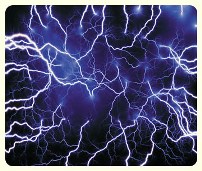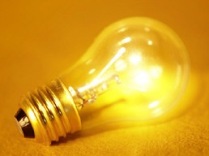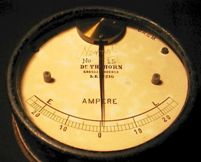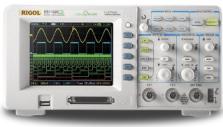Home-made device for protecting the motor from under-phase conditions and overload
 As typical elements of motor protection, electrothermal relays are most often used. Designers are forced to overestimate the rated current of these relays, so that there are no trips at startup. The reliability of such protection is low, and a large percentage of engines fail during operation.
As typical elements of motor protection, electrothermal relays are most often used. Designers are forced to overestimate the rated current of these relays, so that there are no trips at startup. The reliability of such protection is low, and a large percentage of engines fail during operation.
The circuit of the motor protection device (see the figure) from out-of-phase modes and overload is characterized by increased reliability. Transistors VT1, VT2 together with the elements connected to them form an analog of a dynistor, the switching voltage of which (Uin) depends on the ratio R6 / R7. With the ratings indicated on the diagram 30 V < Uon <36 V in the temperature range -15 Resistors R1 ... R3 form a vector adder, at the output of which the voltage is 0, if the motor is full-phase. The transformer T1 is a current sensor of one phase of the electric motor. The outputs of the current sensor and vector adder are connected to a rectifier made on diodes VD1 ... VD3. In normal mode, the voltage at the rectifier output is determined by the current in the primary winding T1 and the ratio of turns wl / w2. Using a resistor R4, this voltage is set below U on VT1 and VT2. If phase failure or motor overload occurs, then ...
How not to spoil your health in the pursuit of energy savings
 In the literature, there is always a theme of saving electricity and extending the life of incandescent lamps. In most articles, a very simple method is proposed - switching a semiconductor diode in series with the lamp.
In the literature, there is always a theme of saving electricity and extending the life of incandescent lamps. In most articles, a very simple method is proposed - switching a semiconductor diode in series with the lamp.
This topic has repeatedly appeared in the magazines "Radio", "Radio amateur", she did not bypass "Radioamator" "[1-4]. They offer a wide variety of solutions: from the simple inclusion of a diode in series with a cartridge [2], the difficult manufacture of a “tablet” [1] and the “prescribing an aspirin bulb” [3] to the manufacture of an “adapter cap” [4]. Moreover, on the pages " "Radioamator" "flares up a quiet debate about whose" pill "is better and how to" swallow "it.
The authors took good care of the "health" and "durability" of the incandescent lamp and completely forgot about their health and the health of their family. "What's the matter?" - you ask. Just in those blinks that suggest masking with the help of a “milky” lampshade [3]. Perhaps there will be an illusion of a decrease in blinks, but this will not reduce them, and their negative impact will not decrease.
So, we can choose which is more important: the health of the light bulb or ours? Is natural light better than artificial? Of course! Why? There can be many answers. And one of them - artificial lighting, for example, incandescent lamps, blinks at a frequency of 100 Hz. Pay attention not to 50 Hz, as it is sometimes mistakenly believed, referring to the frequency of the electrical network. Due to the inertia of our vision, we do not notice flashes, but this does not mean at all that we do not perceive them. They affect the organs of vision and, of course, the human nervous system. We get tired faster ...

Despite the indisputable successes of the modern theory of electromagnetism, the creation on its basis of such directions as electrical engineering, radio engineering, electronics, there is no reason to consider this theory complete.
The main drawback of the existing theory of electromagnetism is the lack of model concepts, a lack of understanding of the essence of electrical processes; hence the practical impossibility of further development and improvement of the theory. And from the limitations of the theory, many applied difficulties also follow.
There are no grounds for believing the theory of electromagnetism to be the height of perfection.In fact, the theory has accumulated a number of omissions and direct paradoxes for which very unsatisfactory explanations have been invented, or there are no such explanations at all.
For example, how to explain that two mutually motionless identical charges, which are supposed to be repelled from each other according to the Coulomb law, are actually attracted if they move together a relatively long-abandoned source? But they are attracted, because now they are currents, and identical currents are attracted, and this has been experimentally proved.
Why is the electromagnetic field energy per unit length of the conductor with the current generating this magnetic field tending to infinity if the return conductor is moved away? Not the energy of the entire conductor, but precisely per unit length, say, one meter? ...
What you need to know when installing an RCD and grounding device in an apartment or private house
 It is not necessary to use RCDs or electronically controlled difavtomats, for example, IEK AD 12, IEK AD 14 diflavtomats, when the phase or neutral conductor breaks, the power of the electronic control circuit is de-energized and the differential protection stops working. There is a diffrel with an electronic control circuit in which, in the event of a power failure, the consumer switches off in the likeness of a starter. To connect the consumer after power is restored, you must manually turn on this type of diffrel. This type of differential switch can be used to power electrical appliances where it is dangerous to re-supply voltage after a power failure.
It is not necessary to use RCDs or electronically controlled difavtomats, for example, IEK AD 12, IEK AD 14 diflavtomats, when the phase or neutral conductor breaks, the power of the electronic control circuit is de-energized and the differential protection stops working. There is a diffrel with an electronic control circuit in which, in the event of a power failure, the consumer switches off in the likeness of a starter. To connect the consumer after power is restored, you must manually turn on this type of diffrel. This type of differential switch can be used to power electrical appliances where it is dangerous to re-supply voltage after a power failure.
With improperly made grounding can be more dangerous than without grounding !!!
Grounding without an RCD or grounding is prohibited !!!
Do not connect the ground terminals of outlets and electrical appliances protected only by circuit breakers that protect only wiring from short circuits in the phase-neutral and phase-phase circuits, to natural, artificial and especially home-made grounding. You expose yourself and others to mortal danger. Automata are triggered only by currents many times higher than the nominal value of the automaton. Natural, artificial and especially home-made grounding in the vast majority of cases has a resistance that cannot create such currents and, accordingly, carry out a protective shutdown of automatic machines within 0.4 seconds normalized by safety ...
To the history of electric lighting
 This story begins with a topic very far from electricity, which confirms the fact that in science there are no secondary or unpromising for study. In 1644 Italian physicist E. Toricelli invented the barometer. The device was a glass tube about a meter long with a sealed end. The other end was dipped in a cup of mercury. In the tube, the mercury did not sink completely, but the so-called “Toricellian emptiness” formed, the volume of which varied due to weather conditions.
This story begins with a topic very far from electricity, which confirms the fact that in science there are no secondary or unpromising for study. In 1644 Italian physicist E. Toricelli invented the barometer. The device was a glass tube about a meter long with a sealed end. The other end was dipped in a cup of mercury. In the tube, the mercury did not sink completely, but the so-called “Toricellian emptiness” formed, the volume of which varied due to weather conditions.
In February 1645 Cardinal Giovanni de Medici ordered that several such pipes be installed in Rome and kept under surveillance. This is surprising for two reasons. Toricelli was a student of G. Galileo, who in recent years has been disgraced for atheism. Secondly, a valuable idea followed from the Catholic hierarch and since then barometric observations began ...
The history of a paradox of electrical engineering
 If you compose an electric circuit from a current source, an energy consumer and the wires connecting them, close it, then an electric current will flow along this circuit. It is reasonable to ask: “And in what direction?” The textbook on the theoretical foundations of electrical engineering gives the answer: “In the external circuit, the current flows from the plus of the energy source to the minus, and in the inside of the source from the minus to the plus”.
If you compose an electric circuit from a current source, an energy consumer and the wires connecting them, close it, then an electric current will flow along this circuit. It is reasonable to ask: “And in what direction?” The textbook on the theoretical foundations of electrical engineering gives the answer: “In the external circuit, the current flows from the plus of the energy source to the minus, and in the inside of the source from the minus to the plus”.
Is it so? Recall that an electric current is the ordered movement of electrically charged particles. Those in metal conductors are negatively charged particles - electrons.But the electrons in the external circuit move just the opposite from the minus of the source to the plus. This can be proved very simply. It is enough to put an electronic lamp - a diode in the above circuit. If the anode of the lamp is positively charged, then the current in the circuit will be, if negative, then there will be no current. Recall that opposite charges attract, and like charges repel. Therefore, the positive anode attracts negative electrons, but not vice versa. We conclude that the direction opposite to the motion of electrons is taken as the direction of electric current in the science of electrical engineering.
The choice of the direction opposite to the existing one cannot be called otherwise paradoxical, but the reasons for such a discrepancy can be explained if we trace the history of the development of electrical engineering as a science.
Among the many theories, sometimes even anecdotal, trying to explain the electrical phenomena that appeared at the dawn of the science of electricity, let us dwell on two main ...
Why do I need an oscilloscope?
 Sooner or later, any novice electronics engineer, if he does not give up his experiments, will grow to circuits where you need to monitor not just currents and voltages, but the operation of the circuit in dynamics. This is especially often needed in various generators and pulse devices. There is nothing to do without an oscilloscope!
Sooner or later, any novice electronics engineer, if he does not give up his experiments, will grow to circuits where you need to monitor not just currents and voltages, but the operation of the circuit in dynamics. This is especially often needed in various generators and pulse devices. There is nothing to do without an oscilloscope!
Scary device, huh? A bunch of pens, some buttons, and even the screen and nifiga is not clear what is here and why. Nothing, we’ll fix it now. Now I’ll tell you how to use the oscilloscope.
In fact, everything is simple here - the oscilloscope, roughly speaking, is just ... voltmeter! Only cunning, able to show a change in the shape of the measured voltage ...
What tool should an electrician have, except for pliers and a set of screwdrivers
 Typically, an electrician going to a customer’s call takes a suitcase or a handbag full of various pieces of iron, screws and dowels, as well as an electrician’s tool in his handbag - the glands with which the electrician performs certain tasks. What tool should he be an electrician?
Typically, an electrician going to a customer’s call takes a suitcase or a handbag full of various pieces of iron, screws and dowels, as well as an electrician’s tool in his handbag - the glands with which the electrician performs certain tasks. What tool should he be an electrician?
Rule of an isolated tool. The most basic association of an electrician with pliers. Pliers (pliers) must be with insulated handles. The insulation material for the pens can be either plastic or rubber. The main thing is that the insulation of the handles can withstand a voltage of 1000 volts. In practice, it’s convenient to have a pair of pliers with you — some medium or small, others large.
As well as pliers, screwdrivers will always come in handy ...
What do we take on a hike?
Collecting an electrician's suitcase is very similar to picking a backpack on a camping trip. It is necessary to foresee all the little things and take as many tools as possible so as not to get into the prosak on a call from a client. However, here, just as in a hiking trip, it is important not to overdo it, otherwise you can simply not bring a suitcase. So, what else does the electrician have in his bag, except for pliers and a set of screwdrivers? ...
